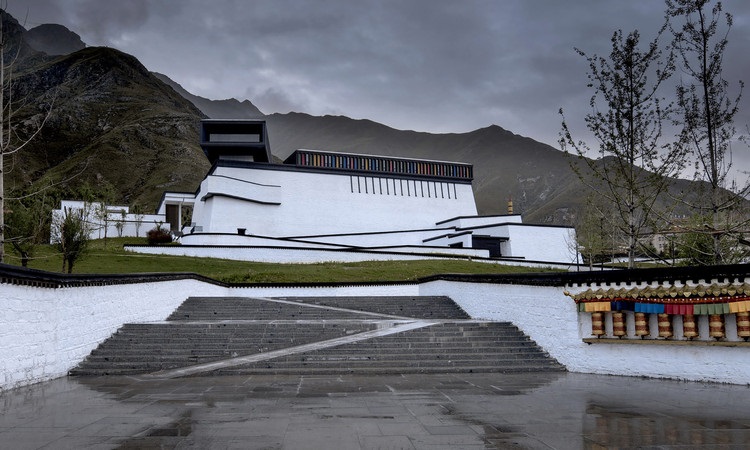
Written by: Saram Maqbool
Posted on: December 30, 2024 |  | 中文
| 中文
Xinglong Bookstore by MUDA-Architects pays homage to ancient Chinese structures with a modern twist.
When we talk of countries where innovation and progress have been taken to new heights, China’s name is bound to come up. The country has grown by leaps and bounds in recent decades, keeping up with the so-called developed world. Among the industries constantly being revolutionized in China is architectural design. While the country is known for its ancient and traditional architecture, it's making incredible strides in the contemporary realm of building design as well. Chinese architects have gained international recognition for their ability to merge modern design philosophies with a deep understanding of traditional aesthetics and local context. Among these trailblazing figures are Ma Yansong, Wang Shu and Zhang Lei, whose works are enough to showcase the dynamic evolution of architecture in modern China.

The Tibet Intangible Cultural Heritage Museum strikes a balance between traditional forms and contemporary minimal design.
Ma Yansong, the founder of MAD Architects, is often celebrated for his futuristic and fluid designs that challenge conventional ideas of form and space. His work is heavily inspired by nature and traditional Chinese landscapes, which he translates into bold and almost alien structures. One of his most iconic projects, the Absolute Towers in Canada, features two twisting skyscrapers that have redefined urban skylines. These look as if they are in a constant state of motion because of how dynamic they are. Back in China, his Harbin Opera House is another testament to his ability to merge architecture with the environment. The opera house's flowing lines and organic forms seem to mimic the surrounding nature, creating a seamless dialogue between the built and the natural world.
Another architect whose work deserves a mention is Wang Shu. Founder of Amateur Architecture Studio, Shu was the first Chinese architect to win the Pritzker Architecture Prize in 2012. His work is deeply rooted in Chinese traditions, emphasizing the use of local materials and sustainable practices. His Ningbo History Museum is a striking example of his approach, constructed using salvaged bricks and tiles from demolished villages. The building’s rugged texture and irregular form reflect the region’s history while addressing contemporary needs.
Zhang Lei, the founder of AZL Architects, is another prominent figure whose work bridges the gap between tradition and modernity. Known for his minimalist approach, Zhang focuses on creating serene, contemplative spaces that strike the perfect balance between tradition and modernism. His Xiangshan Art Commune is an excellent project that combines concrete, wood, and glass to form a tranquil retreat for artists. The design emphasizes spatial clarity and natural light, alongside a sense of calmness. Zhang’s work often incorporates local materials and vernacular techniques, which show a deep respect for regional culture and history. This sensitivity to context is also evident in his Wanjing Garden Chapel, a small but impactful structure that uses light and shadow to create an almost spiritual experience for visitors.
What unites these architects is their ability to address the challenges of contemporary urbanization while remaining deeply connected to Chinese culture and history. Each of them reinterprets traditional principles and techniques to create innovative designs that resonate on both a local and global scale. They challenge the stereotype of modern Chinese architecture as being dominated by rapid, large-scale development and instead highlight the potential for thoughtful, human-centered design.
These architects also represent a broader trend in contemporary Chinese architecture, which is increasingly defined by a commitment to sustainability and environmental integration. China, like many other countries, is battling issues like urban sprawl, pollution and the scarcity of resources. That is where architects like Ma Yansong, Wang Shu and Zhang Lei come in. Whether through recycled materials, green spaces, or energy-efficient systems, their work reflects a growing awareness of the architect’s role in creating a sustainable future.
However, the journey of these architects comes with its own challenges. The rapid pace of development in China often prioritizes speed and scale over quality and innovation. Despite this, architects like Ma, Wang and Zhang continue to advocate for more meaningful designs that are sensitive to their contexts. Their success stories inspire a new generation of architects in China to balance tradition with modernity, innovation with sustainability, and local identity with global relevance.
The work of these architects, like that of many other contemporary architectural practices in China, exemplifies the transformative power of contemporary Chinese architecture. Their designs are not just buildings but narratives that connect the past with the present, the local with the global, and the natural with the built environment. As they continue to push and test the boundaries of design, they are not only redefining Chinese contemporary architecture but are also contributing to the broader discourse on architecture by highlighting the importance of a merger between the new and the old, recycled and reclaimed materials, contextual harmony and respect and sustainability. Their legacy will likely end up shaping what it means to be an architect in China for decades to come, thanks to their vision of a future where innovation and tradition can coexist.
You may also like: